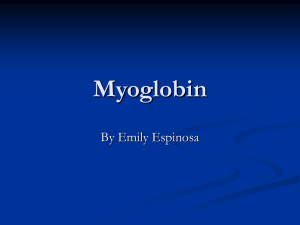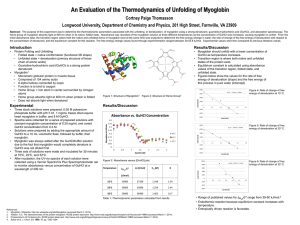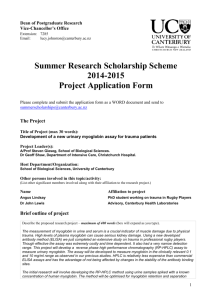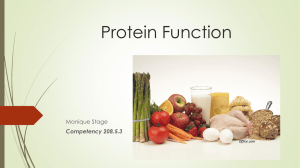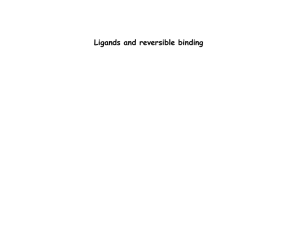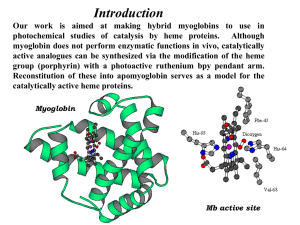Untitled document
advertisement
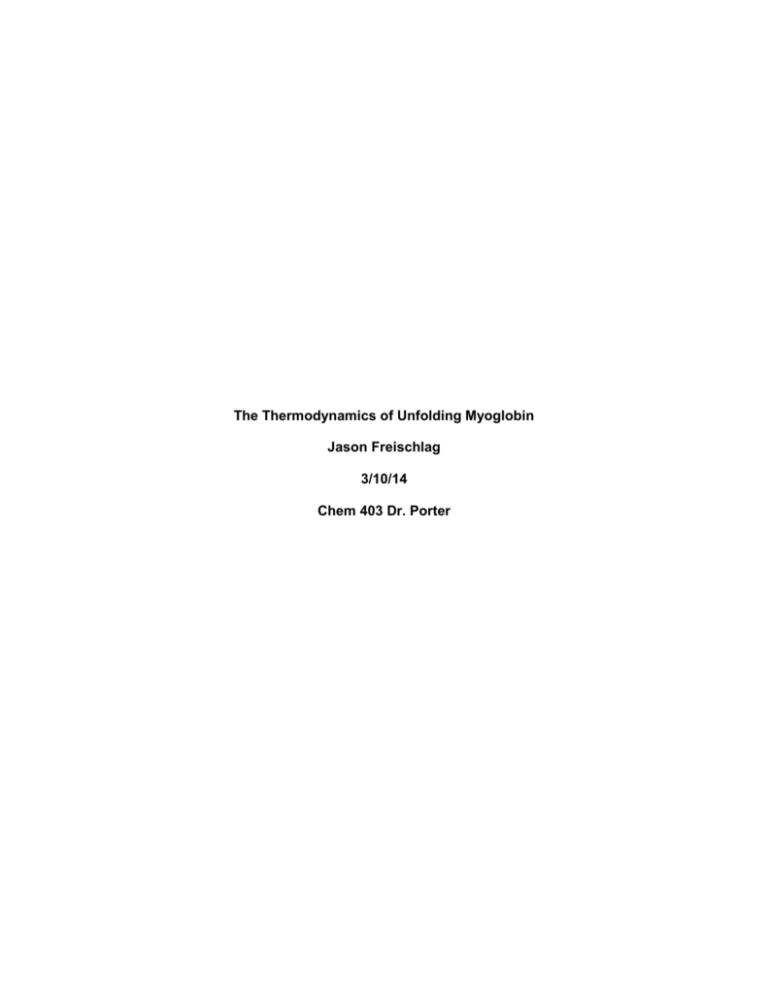
The Thermodynamics of Unfolding Myoglobin Jason Freischlag 3/10/14 Chem 403 Dr. Porter 2 The Thermodynamics of Myoglobin Unfolding – Jason Freischlag Abstract Thermodynamic parameters associated with the unfolding of myoglobin were determined by varying reaction conditions including the amount of denaturant present and the temperature at which the reaction was being carried out. The parameters included the equilibrium constant, K; the free energy of denaturation in water, ΔH2OG0; One such parameter included the equilibrium constant, K at 15 0C, 25 0C, and 32 0C which were found to be 1.54, 7.13, and 14.7 respectively. Another parameter was ΔH2OG0, or the free energy of denaturation in water at a specific temperature, and was also found for 15 0C, 25 0C, and 32 0C to be 33800, 30000, and 53800 Joules per mole respectively. The enthalpy of the system was found to be 94.5 kJ.mol meaning the reaction was endothermic and the entropy of the system was found to be 0.33 kJ/(mol*K). The equilibrium constant, K also raises as temperature increases, another sign of an endothermic reaction. This data supports the idea that as temperature increases myoglobin unfolds more easily. 3 The Thermodynamics of Myoglobin Unfolding – Jason Freischlag Introduction This study examined the thermodynamic process of protein unfolding and the parameters associated with this process by specifically looking at the unfolding of myoglobin in the presence of the denaturant guanidine-HCl. Myoglobin, seen in figure 1, is an iron and oxygen binding protein that contains a heme group. Figure 1. Folded Structure of Myoglobin1 Unfolding of myoglobin refers to the loss of the protein’s structure and the exposal of the heme group which is a functional group in the center of the folded myoglobin that binds oxygen.2 Naturally, this protein is found in muscles so that the bound oxygen, unexposed when the myoglobin is folded, can be released upon exertion when the myoglobin is triggered to unfold. Because this behavior of proteins is so universal it follows that understanding the process of denaturation, or the process of unfolding proteins and exposing internal functional groups, is critical to biological understanding. The two-state equilibrium model 𝑁↔𝑈 is used to represent the ratio of folded and unfolded proteins at specific conditions. N 1) 4 The Thermodynamics of Myoglobin Unfolding – Jason Freischlag represents folded protein, U represents unfolded protein and K, seen in equation 2, represents the equilibrium constant for the reaction. [𝑈] 𝐾 = [𝑁] 2) Guanidine-HCl is the salt of the strong base guanidine and can be seen in figure 2. Figure 2. Guanidine-HCl It is used to denature proteins because it breaks the intramolecular noncovalent interactions of the proteins secondary structure but leaves intact the primary backbone that is comprised of covalent polyamides. This experiment took advantage of the strong absorbance at 409 nm that myoglobin exhibits in its most folded form due to the buried heme group in order to examine the rate of reaction. This allows for certain parameters associated with the reaction to be determined including the equilibrium constant, K; the energy of denaturation in water, ΔH2OG0; the concentration at which there are equal molar amounts of unfolded and folded protein, per specific temperature, Cm; as well as other values associated with the thermodynamics of myoglobin unfolding .3 Procedure Three stock solutions were created and used to create every other necessary solution. One solution of 0.05 M potassium phosphate buffer with a pH of 7, a 1mg/ml myoglobin in that buffer solution, and an 8 M GuHCl solution also in the same buffer. The spectra were measured for a series of solutions that had a constant myoglobin concentration of 0.20 mg/ml, varying GuHCl concentration from 0 M to 3 M and diluted with buffer to 10 ml. Most of the buffer was added before the myoglobin solution so that the reaction does not proceed too quickly. These 5 The Thermodynamics of Myoglobin Unfolding – Jason Freischlag trials were ran three times at different temperatures, 15 0C, 25 0C, and 32 0C. A Vernier Spec 20 was used to record all spectral data. The spectrometer was set to measure absorbance vs concentration at 409 nm and spectra were recorded. Analyses of these spectra are as follows. Results & Discussion The absorbance spectra for each temperature at 409nm described in the procedure section above can be seen in figures 3, 4 and 5 below. absorbance @ 409 nm 0.35 0.3 0.25 0.2 0.15 0.1 0.05 0 0 0.5 1 1.5 2 2.5 3 3.5 3 3.5 Concentration Guanidine HCl [M] Figure 3. 15 0C spectra absorbance @ 409 nm 0.4 0.35 0.3 0.25 0.2 0.15 0.1 0.05 0 0 0.5 1 1.5 2 2.5 Concentration Guanidine HCl [M] Figure 4. 25 0C Spectra 6 absorbance @ 409 nm The Thermodynamics of Myoglobin Unfolding – Jason Freischlag 0.4 0.35 0.3 0.25 0.2 0.15 0.1 0.05 0 0 1 2 3 4 Concentration Guanidine HCl [M] Figure 5. 32 0C Spectra By looking at each individual spectra it can be seen that as GuHCl concentration increases the absorbance decreased which makes sense because the unfolded protein absorbs less and GuHCl is the unfolding agent in the reaction. The free energy of denaturation, ∆𝑢 𝐺 𝑜 , is related to ∆𝐻2 𝑂 𝐺 𝑜 by the equation ∆𝑢 𝐺 𝑜 = ∆𝐻2 𝑂 𝐺 𝑜 − 𝑚𝐶 3) where ∆𝐻2 𝑂 𝐺 𝑜 (J/mol) is the energy of this process in water without denaturant, m (JL/mol2) is the rate of change of the free energy of denaturation with respect to C (mol/L) which is the concentration of GuHCl. ∆𝑢 𝐺 𝑜 can also be experimentally determined using the relationship 𝐴 −𝐴 𝑛 ∆𝑢 𝐺 𝑜 = −𝑅𝑇𝑙𝑛 (𝑘) = −𝑅𝑇𝑙𝑛 (𝐴−𝐴 ) 𝑢 4) where An is the absorbance for myoglobin for GuHCl concentration of 0 M and Au is the absorbance of myoglobin at large GuHCl concentration. A is the absorbance of myoglobin at intermediate values of GuHCl concentration. For small concentrations of GuHCl the myoglobin is in its folded state and for large concentrations of GuHCl the myoglobin is in its unfolded state but there lies a region in-between in which both forms are present called the transition region. In the special case that the concentration of unfolded protein is equal to the concentration of folded protein then k is equal to one, ∆𝑢 𝐺 𝑜 is equal to zero and ∆𝐻2 0 𝐺 𝑜 is equal to mCm where Cm is the concentration of the unfolded and folded protein, which since these are equal Cm is a single 7 The Thermodynamics of Myoglobin Unfolding – Jason Freischlag value that varies according to temperature. ∆𝐻2 0 𝐺 𝑜 , m, and Cm were determined for each temperature based on absorbance spectroscopy. By plotting equation 3 in the transition region values for ∆𝐻2 0 𝐺 𝑜 and m can be determined from the slope and y-intercept for each temperature. Then using the relationship ∆𝐻2 0 𝐺 𝑜 = 𝑚𝐶𝑚 Cm can be determined for each temperature from the other two values found from the graphs. Figures 6, 7, and 8 below show the plotting of equation 3. 8000 6000 ΔuG0 4000 ΔuG0 = -30526C+ 38409 2000 0 -2000 1 1.1 1.2 1.3 1.4 1.5 -4000 -6000 Concentration Guanidine HCl [M] Figure 6. Determination of Free Energy Change in Water @ 15 0C 8000 6000 4000 ΔuG0 ΔuG0 = -23925C + 29999 2000 0 1 1.1 1.2 1.3 -2000 -4000 -6000 Concentration Guanidine HCl [M] Figure 7. Determination of Free Energy Change in Water @ 22 0C 1.4 1.5 8 The Thermodynamics of Myoglobin Unfolding – Jason Freischlag 10000 8000 6000 ΔuG0= -38371C + 53812 ΔuG0 4000 2000 0 -2000 1 1.1 1.2 1.3 1.4 1.5 1.6 -4000 -6000 Concentration Guanidine HCl [M] Figure 8. Determination of Free Energy Change in Water @ 32 0C From the slopes of these three graphs above it is possible to solve for m while the intercept allows for Cm to be determined, both from equation 3. Once these values have been found then ΔH2OG0 can be found using equation 4. Table 1 below shows all of these determined values. K in this table represents the equilibrium constant; the fraction of unfolded protein over folded protein when at equilibrium. The equilibrium constants for each temperature, K, were solved for by combining equations 3 and 4. Table 1. Determined Values Temp (0C) ΔH2OG0 (J/mol) 15 33800 22 30000 32 53800 m (J/mol) 27100 23900 38400 Cm (M) 1.248 1.254 1.402 K 1.54 7.13 14.7 The fraction of unfolded protein is given by 𝑓= [𝑈] [𝑈]+[𝑁] 5) 𝑓= 𝐾 1+𝐾 6) and is also related to K by Using the relationship between K and A seen earlier equation 6 can also be written as 9 The Thermodynamics of Myoglobin Unfolding – Jason Freischlag 𝑓𝑒𝑥𝑝 = 𝐴𝑛 −𝐴 𝐴𝑛 − 𝐴𝑢 7) and the relationship between K and free energy change and equation 3 can be combined to give the following two state model equation 𝑓𝑐𝑎𝑙𝑐 = (𝐶 −𝐶) exp[−𝑚 𝑚 ] 𝑅𝑇 8) (𝐶 −𝐶) 1+exp[−𝑚 𝑚 ] 𝑅𝑇 Equation 8 was then fit to equation 7 using non-linear sum of squares. The solver excel tool was used to minimize the sum of squares calculated from the residual difference between f (exp) and f(calc). The results of this fitting process are the fraction of unfolded protein graphs shown in Fraction of Molecules unfolded figures 9, 10 and 11. 1.2 1 0.8 0.6 f(calc) 0.4 f(exp) 0.2 resid 0 -0.2 1 1.2 1.4 [GuHCl] 1.6 1.8 Fraction molecules unfolded Figure 9. Fraction of Molecules Unfolded for 15 0C 1.2 1 0.8 0.6 f(calc) 0.4 f(exp) 0.2 resid 0 -0.2 1 1.2 1.4 [GuHCl] 1.6 Figure 10. Fraction of Molecules Unfolded for 25 0C 1.8 10 The Thermodynamics of Myoglobin Unfolding – Jason Freischlag Fraction Molecules Unfolded 1.2 1 0.8 0.6 f (calc) 0.4 f (exp) 0.2 resid 0 -0.2 1 1.2 1.4 [GuHCl] 1.6 1.8 Figure 11. Fraction of Molecules Unfolded for 32 0C As can be seen from the residuals of these graphs the results obtained experimentally match the calculated results well. Comparison of m values from each method also shows that the results match. Table 2 below shows the comparison of m values and the corresponding percent errors. Comparison of Cm values in table 3 show even more positive results. Table 2. Comparison of m values Temp (0C) 15 22 32 mexperimental 30500 23900 38400 mcalc 28700 25700 31600 % error 6.27 7.00 21.52 Cm(calc) 1.253 1.260 1.400 % error 0.64 0.63 0.14 Table 3. Comparison of Cm Values Temp (0C) 15 22 32 Cm(experimental) 1.261 1.252 1.402 The enthalpy, ∆𝐻 and entropy,∆𝑆 associated with the unfolding of myoglobin can be found by combining equation 9 below ln(𝐾) = −∆𝐺/𝑅𝑇 9) with the Gibbs free energy equation seen in equation 10 ∆𝐺 = ∆𝐻 − 𝑇∆𝑆 10) 11 The Thermodynamics of Myoglobin Unfolding – Jason Freischlag gives equation 11 which is a linear relationship and can be plotted to solve for ∆𝐻 and ∆𝑆. ln(𝐾) = −∆𝐻 𝑅 1 ∗𝑇+ ∆𝑆 𝑅 11) The graph showing equation 11 plotted can be seen in figure 12. 3 ln(K) ln(K) = -11367(1/T) + 40.117 2 1 0 0.00325 0.0033 0.00335 0.0034 0.00345 0.0035 1/ T (1/K) Figure 12. Determination of Enthalpy and Entropy Associated with Myoglobin Unfolding The literature value for ∆𝐺 at 25 0c was given in a range of 30 kJ/mol – 49 kJ/mol compared to the experimental value of 30 KJ/mol.2 Enthalpy and entropy values were not reported in the literature but were found to be 94.5 kJ.mol and 0.33 kJ/(mol*K). Because the enthalpy is positive and K increases as temperature increases this reaction is said to be endothermic. Although this process is endothermic it can still be made spontaneous (−∆𝐺) as seen in equation 10 when the temperature is high enough to make the entropy term overcome the enthalpy term. Conclusion The enthalpy value of 94.5 kJ/mol and the trend that K increases as temperature increases supports the claim that this process is on endothermic reaction. Future work in this research may include the addition of more temperatures to increase the number of points contributing to the determination of enthalpy and entropy. In conclusion, the non-linear fitting method of sum of squares is sufficient for examining the unfolding process of myoglobin and gives results consistent with those found in literature. 12 The Thermodynamics of Myoglobin Unfolding – Jason Freischlag References 1. Laboratory Handout. “The thermodynamics of Unfolding Myoglobin” CHEM 403. Spring 2014. 2. Sykes, Paul A., Harn-Cherng Shiue, Jon R. Walker, and Robert C. Bateman, Jr. "Determination of Myoglobin Stability by Visible Spectroscopy." Determination of Myoglobin Stability by Visible Spectroscopy. N.p., Sept. 1999. Web. 08 Mar. 2014. 3. Zwanzig, Robert. "Two State Models of Protein Folding." N.p., 11 Nov. 1996. Web. 8 Mar. 2014.
